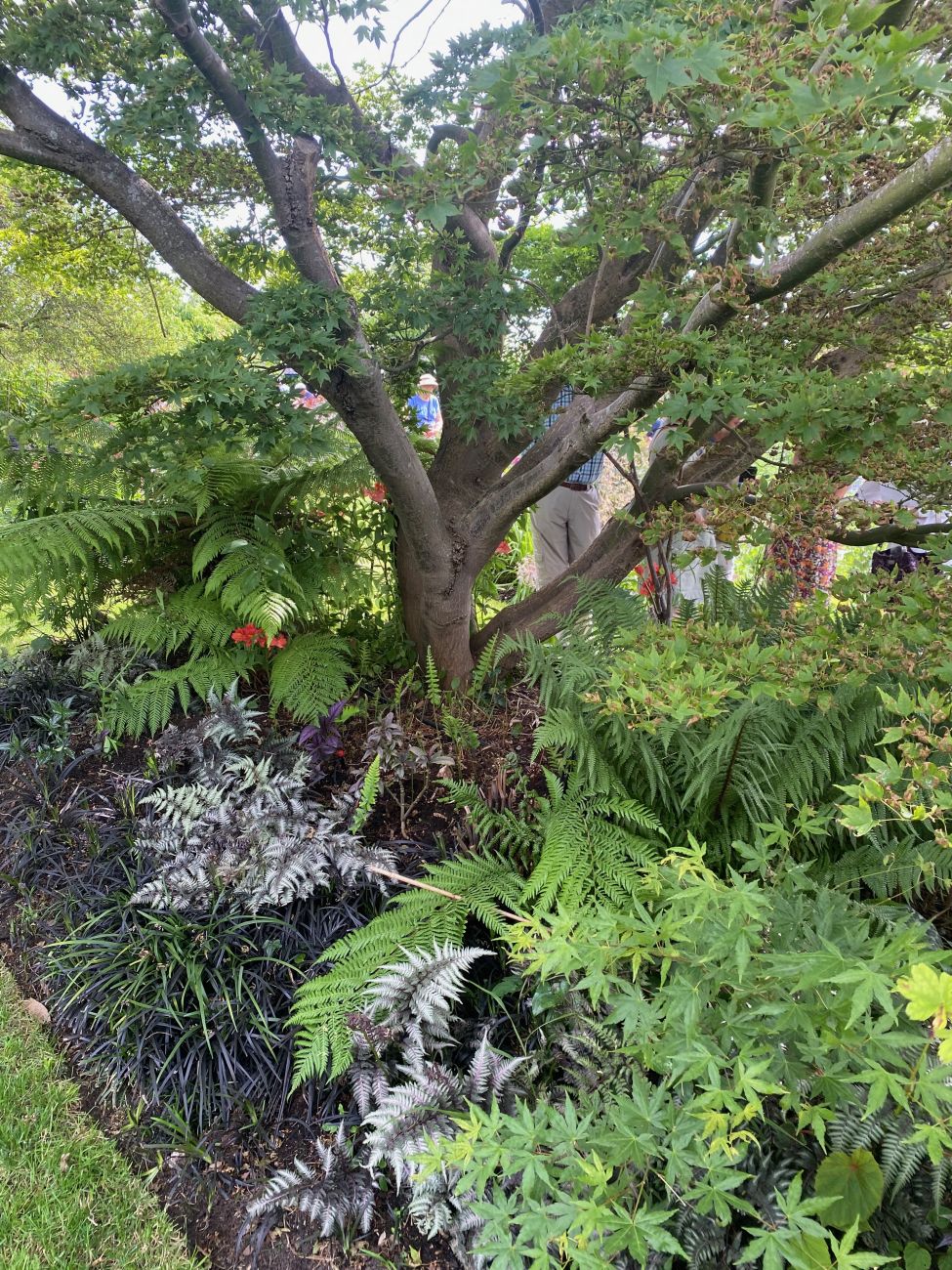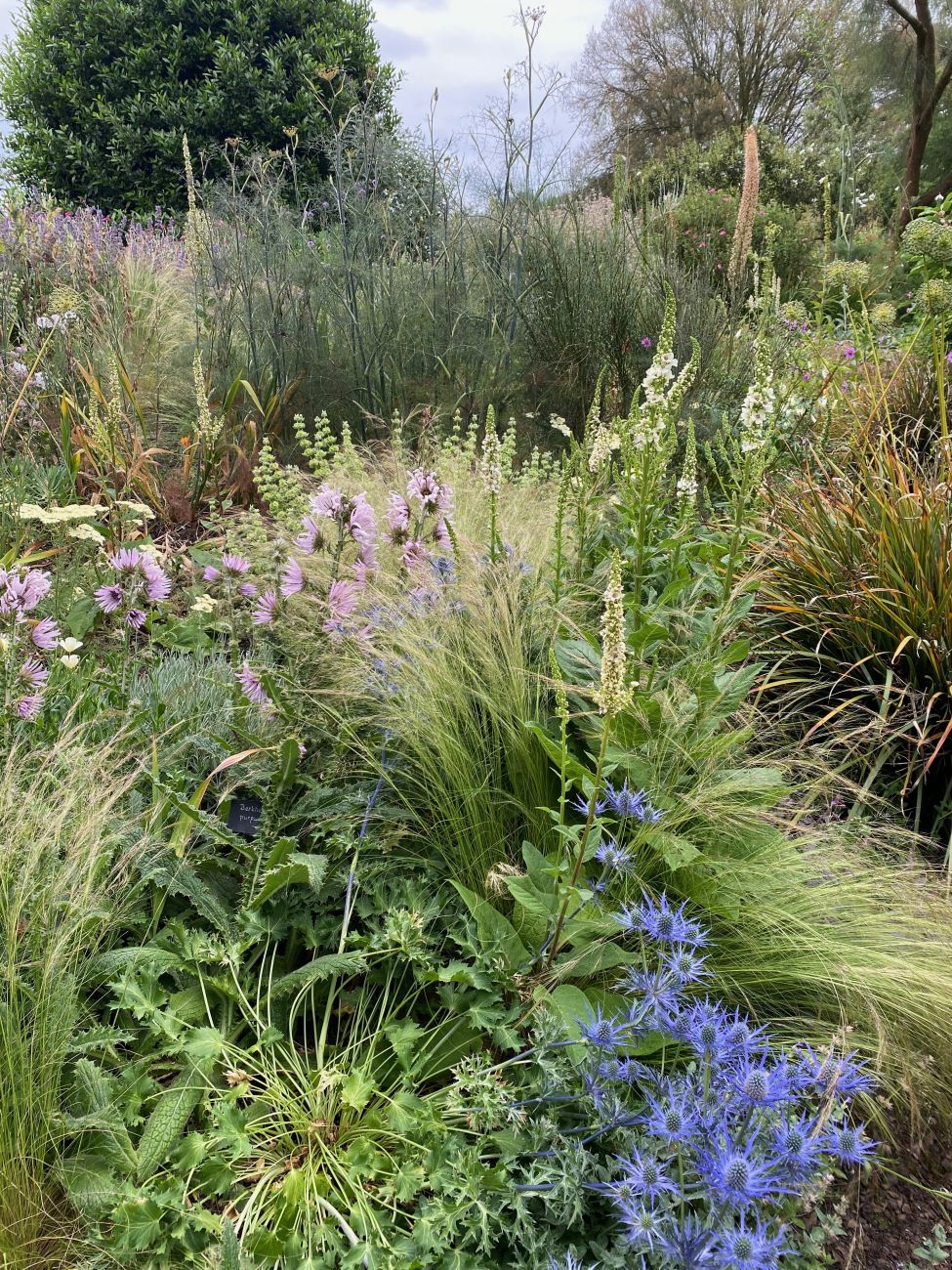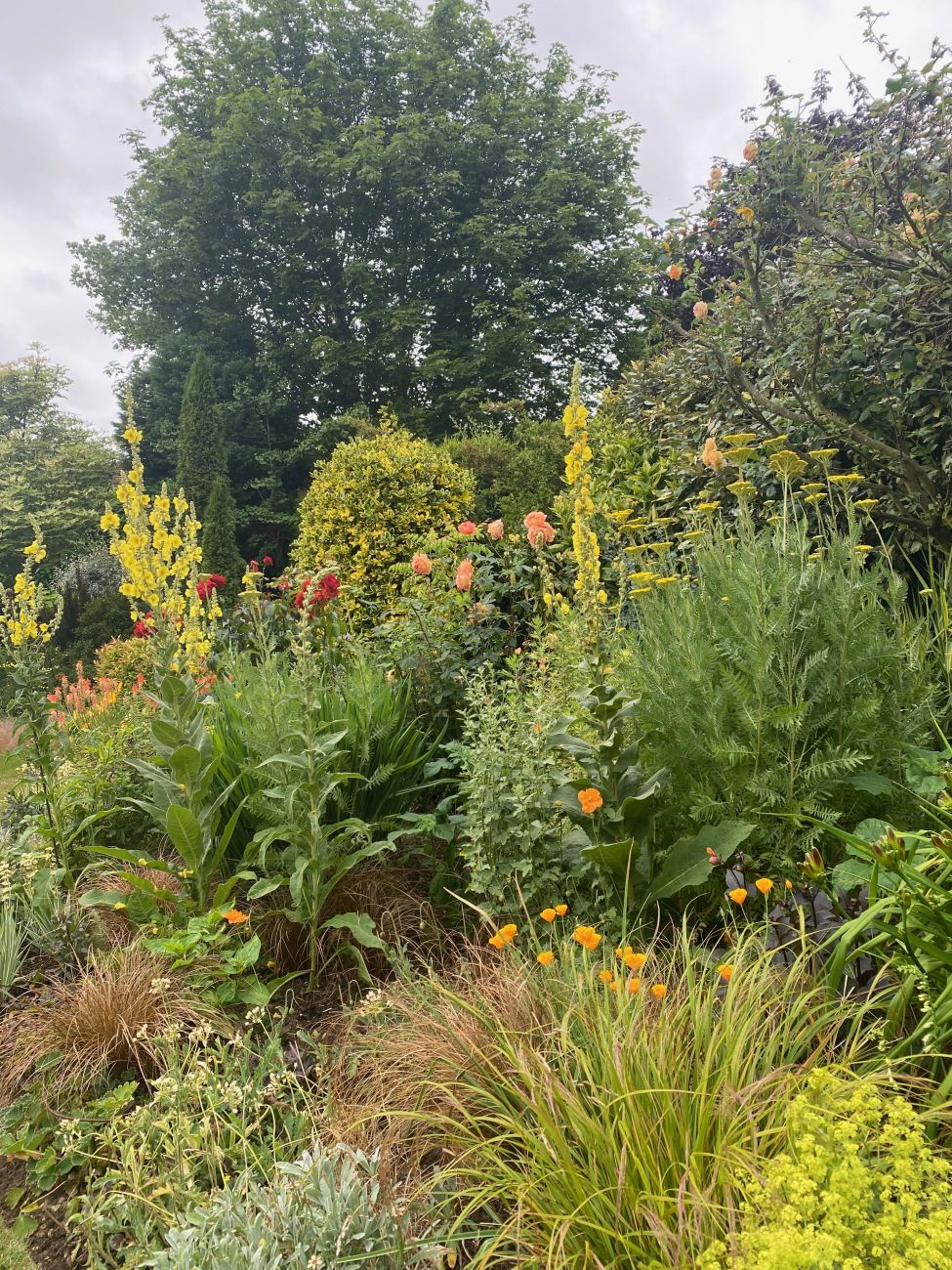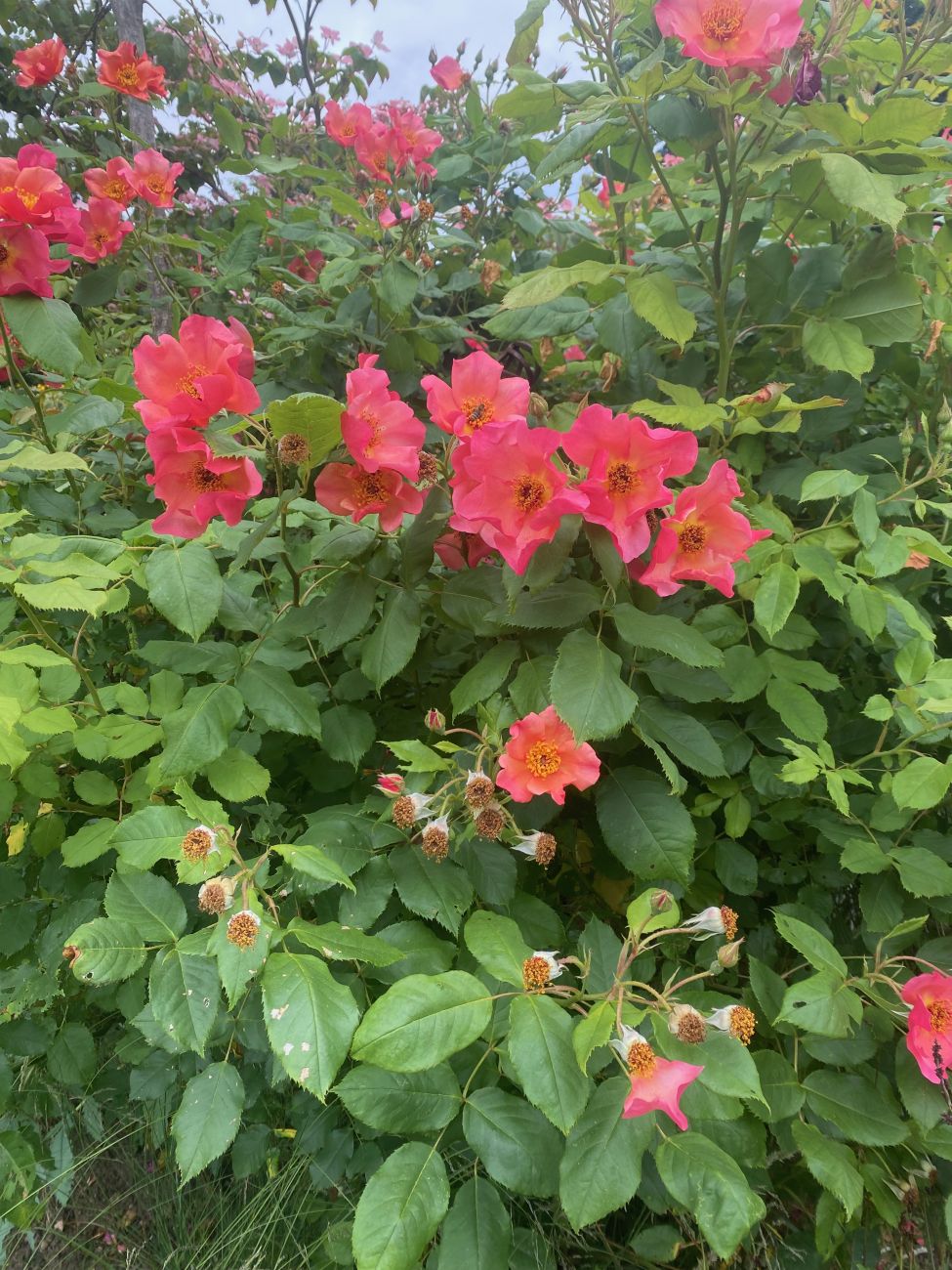Essex Summer Gardens Tour
Sunday 25 to Thursday 29 June 2023
Our visit could not have been better timed. We visited 11 gardens over three and a half days at the end of June, all but the last in Mediterranean sunshine, including two famously very dry gardens at their peak. We were based at Wivenhoe House Hotel which is a former stately pile on the extensive campus of the University of Essex in Colchester. Friendly and comfortable.
Our first garden was Kamala near Hockley. From the road you would scarcely know it was there, although the drive planted with deep purple Salvia ‘Love and Wishes’, the tender purple bell vine Rhodochiton atrosanguineus, cosmos still in bud, and varied aeoniums was immediately enticing. At the far end a chatty parrot welcomed us to an explosion of colour in borders of close planting and real design artistry. The wonder is that petite pretty Karen Mann cares for this third of an acre entirely alone. So many of the plants are tender and must be moved to the greenhouses for winter, the garden manured, then replanted in spring. She has a gift for companion planting, so that although the beds are crammed with dahlias, salvias, gingers, brugmansia, bananas, bamboos, grasses, poppies, canna and much, much more the plants seem so comfortable and complementary to their neighbours. Acers, the rare dramatic Arbutilon ‘Red Tiger’, especially enchanted us. Karen is entirely self-taught. Not a deadhead in sight, she had presumably been up since before dawn.




It is a somewhat crass understatement to say Kamala is a labour of love. Karen and her husband had moved to their specially adapted bungalow with their severely disabled student son Jake who had muscular dystrophy. Jake died in 2014 and, as Karen explained, it was only gardening that helped her through intense grief, coupled with a challenge to open the garden on selected days through the National Garden Scheme, particularly in aid of the local hospice that had supported the family so well.
One day in the spring following Jake’s death, Karen spotted a mysterious tree dahlia seedling. She is quite a dahlia guru but this stumped her. With the help of the RHS Dahlia Committee it was pronounced to be a cross between Dahlia excelsia and Dahlia ‘Blue bayou’. It is a magnificent shade of deep pink-crimson and a prolific bloomer. Today it is named Dahlia ‘Jake Mann’, a plant that speaks to Karen of immortality.

Our next rather brief stop was RHS Hyde Hall where many of us headed off to the Dry Garden. Here verbascums stood like beaming lordly soldiers overlooking their territory which hosts some 400 species which thrive on poor stony soils, their origins from Mediterranean climates worldwide. Delicate waving grasses were a gracious contrast to the expansive verbascums. Guy’s pictures tell the story, and I will not linger here as the garden is familiar to so many. We were lucky to see it at peak midsummer flowering. Indeed, that day we could have been in the Med.





And so on to Peacocks at Margaretting, another garden opening in aid of the local hospice. Here was further contrast: ten acres including many native and specimen trees and woodland walks, and cherishing a series of differently themed garden ‘rooms’ that owner Phil Torr is still devising. He too came to gardening following tragedy, the early death of his wife. This garden is famed for its agapanthus, especially the whites, but as he and so many others told us, many had not survived the cruel week of frost and snow of December 2022.They are usually like ghosts in the evening, he told us, but scarcely this summer.
But there is plenty of interest: the Temple of Athena on the far side of the lily lake, a wildflower meadow with beehives and bug hotels inspired by Great Dixter, a gigantic copper beech overlooking a small waterfall and pond. The Garden of Reconciliation is a fusion of ideas. Including a water feature with a Christian cross but also evoking the Islamic Gardens of the Alhambra, a Hindu plaque, a pagan Green Man, a medlar tree from the Middle East. All protected on one side by tall neat hornbeams underplanted with grasses. On another side is a clever walkway with a canopy of bamboo, supported by bamboo ‘pillars’ (many bamboo poles tied together coating a steel column), an idea Phil said he took from the Yves St Laurent garden in Morocco.
Our last visit of the day was to Fudlers Hall at Mashbury overlooking the Chelmer Valley. For rose enthusiasts this was a romantic dream. Well established ramblers romped away over pergolas, arches and walls, their precise varieties often long forgotten. I was struck by a fabulous collection of soft yellow Rosa ‘Buff Beauty’ in a bed beneath a window. Delicious Rosa ‘Gertrude Jekyll’ was on fine form too. Mature mixed borders were notably packed with delphiniums – this part of Essex must be slug and snail free. A 500-year-old yew tree dominates the front garden – what a pity, spoiling the view, I ignorantly thought, but owner Mrs Meacock said it was a blessing in high summer, giving shade, and cooling the house. Altogether a charming welcome in a beautifully matured two-acre garden.




Next day we set off early to Tinkers Green Farm near Braintree, quite a journey, but worth the ride. Denny Swete is a garden designer who started here with a field. Aside from magnificent wide herbaceous borders – a great deal of work – she has created a huge potager packed with vegetables, cutting flowers, fruit trees, healthy box, and a few plants for sale. We were offered homemade cakes wherever we went, but perhaps these were the best. Denny has a way with the simplest of flowers – for instance, she had a dazzling display of Alchemilla mollis and geraniums tumbling down into the drive: so simple, so effective. There was a lot to learn from her packed potager too.






As always on such trips, we had to race on. And so next to Polstead Mill near Colchester where for sure we will all first remember the stunning kitchen garden lunch of delicious salads and tarts. Secondly, we may reflect on the cardoons so artfully placed against a high wall and tucked among them a witty metal replica that fooled a few of us to begin with. The house dates from 1785, with the adjacent former mill added in 1947. The Bartletts have been here since 2002, transforming the 11 acres with new bridges across the River Box, a wildflower meadow, and flamboyant herbaceous borders. In 2009 they added an extensive kitchen garden covering an acre. Apples, pears, figs line the redbrick walls. The prolific raised beds provide expertly trained combinations of fruits and vegetables – clearly one of Lucy’s favourite colours is purple, contrasted by pale grey, and the deep shades of scrambling nasturtiums. When she is not gardening, energetic Lucy runs Ingredients for Cooks, a wholesale business sourcing thousands of offerings in bulk to professionals and keen amateurs alike.




From there, the The Beth Chatto Gardens and nursery just outside Colchester needs little introduction to MPG members (or most of the gardening world for that matter). On what would have been Beth’s 100th birthday her spirit must have soared over her colourful legacy in the Gravel Garden where a wide variety of alliums, salvias, verbenas, alstroemerias, eryngiums, poppies, euphorbias, bergenias, grasses and heaps more looked magnificent on the free-draining sand and gravel of a former car park. Particularly lovely was a lofty flowering Genista aetnensis (Mount Etna broom). Notable absentees this year included many signs of imminent agapanthus thanks to the ferocious freeze of the previous December. Famously Beth never permitted watering apart from helping plants in their first year however high the temperature. Rich soil preparation was her mantra. December 2022, cold or not, the results for us were as expected — outstanding.
In sharp contrast, the Water Garden is a sea of greens, packed with ferns, hostas, irises, primulas and more, and recommended for a boiling day because the temperature is degrees lower than in the Gravel Garden. Further on the Woodland Garden is shaded by mature oaks – I have never forgotten walking with Beth discussing articles she was to write for the Telegraph magazine. As we strolled on a dull winter afternoon she gathered a posy of Arum italicum, flowering Sarcococca varieties, snowdrops and a few precious Narcissus ‘Cedric Morris’ – this last originally collected in the wild by Morris and first propagated by Beth. An unforgettable gift.
A further point about a visit here: the extensive nursery is organised according to habitat – Mediterranean, damp, woodland, etc. Very helpful to shoppers looking for inspiration to fill a particular patch.






Day Three began with a visit to Furzelea at Danbury, a long deep garden that was instantly a firm favourite as we explored the meandering sloping paths passing richly crammed borders. Avril and Roger Cole-Jones have created what someone described as ‘a garden of wonders’, a plot that is bursting with shrubs and herbaceous perennials. Undoubtedly stunning in spring and autumn too. The box hedge and edge clipping alone is surely a non-stop preoccupation for them. In full bloom was the beautiful single coral shrub Rosa ‘Morning Mist’. Equally prolific was the apricot-cream-red Rosa ‘Fighting Temeraire’ making a vigorous splash. This garden is truly special and widely appreciated.


From there to Ulting Wick near Maldon, eight acres based in what was an old working farmyard that includes several listed black barns. This garden is famed for its many thousands of snowdrops and tulips, then dahlias, grasses and annuals. Raised beds support an organic vegetable garden that works on a three-bed rotation scheme. Beautiful sweet peas were prolific. A bridge covered with Rosa ‘New Dawn’ crosses to an extensive wetland garden lined by dramatic gunnera and other damp lovers. The front of the house was replanted in 2010 inspired by the Beth Chatto Gardens, and large dramatically planted pots sit beneath the windows.



Our last garden of the day was Feeringbury Manor, ten acres with two ponds including the River Blackwater and extensive mature mixed woodland. It sits on an ancient site once owned by William the Conqueror. Rosa ‘Rambling Rector’, or was it ‘Wedding Day’, clambered through trees including euonymus, sorbus and crab apples, One or two ancient much stapled urns were filled with tumbling mixtures of perennials and annuals. The garden may be mature with many choice plants, but a dramatic modern touch is various steel sculptures and gates by Ben Coode-Adams, son of owners Giles and Sonia.






The final morning dawned very wet indeed, and so was the visit to Horkesley Hall, an 1820s Grade II listed house set in eight acres where owner Polly Eddis was on hand to show us around. The grounds were planted by Polly’s father-in-law, adding a selection of specimen trees to accompany the old parkland specimens that surround the lake below the house. An avenue of Pyrus calleryana ‘Chanticleer’ leads from pony paddocks to the woodland garden. Polly told us how in spring the garden bursts into colour with aconites and snowdrops first then narcissus and scillas. We had to use our imagination as the rain poured down. Many of the mature specimen trees need removing having been closely planted. This loved family garden is alive and changing as it grows under Polly’s guidance.





Aside from the gardens we appreciated the well driven spacious coach, particularly as some roads were very narrow. At one stage on a tight lane en route to Ulting Wick we came face to face with a gigantic stuck loader occupying the width of the road to transport a swimming pool shell. Nothing for it but to walk the last quarter of a mile.
We had enjoyed the variety and interest over our few days. Although Essex is famously dry, we realised we had seen a good number of lakes on our travels. Also we were interested in the varied farmland, including misty blue fields of flax (for oil) and phacelia (for fixing nitrogen, attracting insects particularly bees for honey production, animal feed, and more). Overall a happy and educational summer visit with good friends.
Thank you especially to Sue Tymon for her excellent organisation of this full itinerary, and to members for photographs.
Text: Juliet Walker
Images: Guy Cheeseman, Sue Tymon, Juliet Walker, Maddy Hughes

